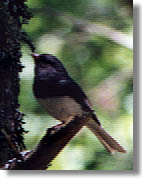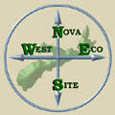Black-and-white Warbler Mniotilta varia
 Height is between four to five inches, from head to tail. Colour is
chiefly slate-black and white stripes, with males being more bright than females, which
tend to be beige. To distinguish between the sexes, look for a black throat for the
male, or a white throat for the female. The National Audubon Society defines the
Black-and-white Warbler's song as "a high, thin, weesy-weesy-weesy; or a pit or zeet". This bird inhabits mixed stands. It is one of the first migrant breeding birds to arrive as early as late April. The
early breeding period has been attributed to this warbler's main food source, which is bark
insects. A distinct behavioural characteristic is the bird's tendency to stay on the
ground or tree trunks while hunting for insects. Breeding range is mainly clustered
in the southwestern area of North America with the northern breeding range limit being
Newfoundland. There is a tight north-western breeding range extending out from the
south-western cluster, centred mainly on the Canadian Rockies in northern Alberta. While being the earliest breeding arrival, this warbler may stay the longest as
well. Black-and-white warblers have been seen in Nova Scotia as late as early
December. Nests may be found in mixed wood stands near the ground, well concealed in
a small tree, usually containing four eggs. Gestation or laying period is between
June to late July.
Height is between four to five inches, from head to tail. Colour is
chiefly slate-black and white stripes, with males being more bright than females, which
tend to be beige. To distinguish between the sexes, look for a black throat for the
male, or a white throat for the female. The National Audubon Society defines the
Black-and-white Warbler's song as "a high, thin, weesy-weesy-weesy; or a pit or zeet". This bird inhabits mixed stands. It is one of the first migrant breeding birds to arrive as early as late April. The
early breeding period has been attributed to this warbler's main food source, which is bark
insects. A distinct behavioural characteristic is the bird's tendency to stay on the
ground or tree trunks while hunting for insects. Breeding range is mainly clustered
in the southwestern area of North America with the northern breeding range limit being
Newfoundland. There is a tight north-western breeding range extending out from the
south-western cluster, centred mainly on the Canadian Rockies in northern Alberta. While being the earliest breeding arrival, this warbler may stay the longest as
well. Black-and-white warblers have been seen in Nova Scotia as late as early
December. Nests may be found in mixed wood stands near the ground, well concealed in
a small tree, usually containing four eggs. Gestation or laying period is between
June to late July.
Yellow Warbler Dendroica petechia
The back and head of the Yellow Warbler is yellow-green, with the males
having narrow red stripes on their breast, and immature yellow warblers are green in
color. This warbler is about five inches tall, from head to tail. The National
Audubon Society defines the warbler's call as sweet-sweet-sweet, sitta, sitta, see.
Yellow Warbler's gestation period is from May to June and nest will continue between
four-five eggs. Nests may be built in low bushes. Larger birds may intrude
upon warblers' nests not only for food but to lay their own eggs as well. Warblers
retaliate by adding more nesting material to cover the foreign eggs. The warbler's
chief staple is insects. Habitation consists of mainly deciduous stands, located near
a stream or wetland. This bird is a mid-range migrant breeding bird for Nova
Scotia. The migrant breeding perimeter lies in Northwestern Yukon, to the Southern
states of America.
Yellow-Rumped Warbler (Myrtle Warbler) Dendroica
coronata
 The head and shoulders of the breeding male warbler are slate-blue, with a
yellow patch on the warbler's forehead, two flanking the breast, and one on the
rump. A light-black patch flares back from the breeding male's eyes in the typical
bandit-like fashion. Non-breeding males, females, and immatures are duller in colour
with brown as the dominant colour. Size for these warblers is from five to six
inches from head to tail. A representative for all warblers' calls, the
Yellow-Rumped Warbler's song consists of a thin warbling twee-twee-twee or a
sharp chek! according to the National Audubon Society. The Myrtle or
Yellow-Rumped warbler favours homogeneous conifer (softwood) stands. Nests are
usually found in spruce trees at low heights. The nest may contain three to five
eggs. Gestation or laying period is from late May to mid-June. Breeding
migration perimeters are from Alaska to Newfoundland with a southern perimeter roughly
even with the Canadian-U.S. border until the western coast is reached, then the range
drops down to include the western quarter of the United States. Wintering
range for this warbler starts within the western quarter of Nova Scotia--the Annapolis
Valley and flares down to include the southeastern half of the United States, then tapers
back up to include the western coastline. Fundamentally, the winter and breeding
patterns overlap from the Annapolis Valley in Nova Scotia to Maine, and again along the
southwestern coastline of the United States.
The head and shoulders of the breeding male warbler are slate-blue, with a
yellow patch on the warbler's forehead, two flanking the breast, and one on the
rump. A light-black patch flares back from the breeding male's eyes in the typical
bandit-like fashion. Non-breeding males, females, and immatures are duller in colour
with brown as the dominant colour. Size for these warblers is from five to six
inches from head to tail. A representative for all warblers' calls, the
Yellow-Rumped Warbler's song consists of a thin warbling twee-twee-twee or a
sharp chek! according to the National Audubon Society. The Myrtle or
Yellow-Rumped warbler favours homogeneous conifer (softwood) stands. Nests are
usually found in spruce trees at low heights. The nest may contain three to five
eggs. Gestation or laying period is from late May to mid-June. Breeding
migration perimeters are from Alaska to Newfoundland with a southern perimeter roughly
even with the Canadian-U.S. border until the western coast is reached, then the range
drops down to include the western quarter of the United States. Wintering
range for this warbler starts within the western quarter of Nova Scotia--the Annapolis
Valley and flares down to include the southeastern half of the United States, then tapers
back up to include the western coastline. Fundamentally, the winter and breeding
patterns overlap from the Annapolis Valley in Nova Scotia to Maine, and again along the
southwestern coastline of the United States.
Common Yellowthroat Geothlypis trichas
The size of this bird is between four to six inches. The colour of
this warbler's back is a dirty yellow with a greenish hue, and mature males can be
distinguished by their black face masks. Their song or call consists of a witchity-witchity-witchity-witchity-wit
or a tchip or chik as defined by the National Audubon Society.
Male warblers can be distinguished further by sudden flying outbursts from low coverage
during the breeding season. Common Yellowthroats approach and leave their nests
discreetly which are located low to the ground, well hidden in wetland thickets sometimes
adjacent to an open area. Eggs number from four to five with the laying period
beginning in early June and continuing to late July. The breeding range includes the southern
two-thirds of North America. Wintering range constitutes the entire coastline of the
United States.




